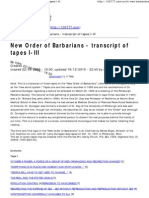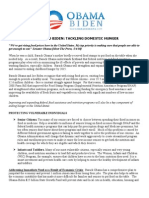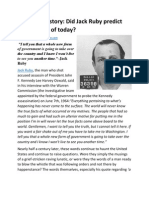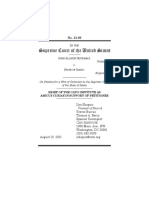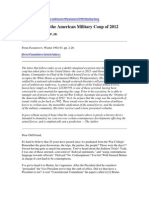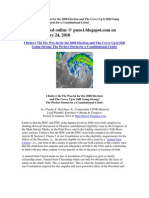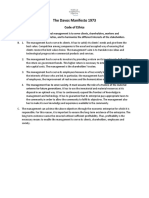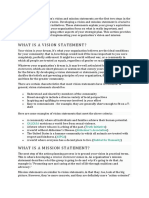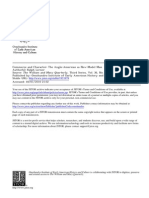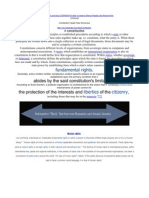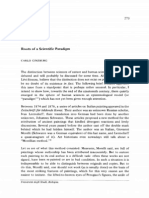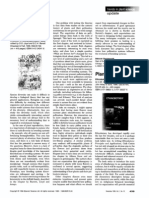Black Ghandi
Black Ghandi
Uploaded by
5705robinCopyright:
Available Formats
Black Ghandi
Black Ghandi
Uploaded by
5705robinOriginal Description:
Copyright
Available Formats
Share this document
Did you find this document useful?
Is this content inappropriate?
Copyright:
Available Formats
Black Ghandi
Black Ghandi
Uploaded by
5705robinCopyright:
Available Formats
Social Scientist
Black Gandhi Author(s): Vijay Prashad Reviewed work(s): Source: Social Scientist, Vol. 37, No. 1/2 (Jan. - Feb., 2009), pp. 3-20 Published by: Social Scientist Stable URL: http://www.jstor.org/stable/27644307 . Accessed: 18/01/2012 11:38
Your use of the JSTOR archive indicates your acceptance of the Terms & Conditions of Use, available at . http://www.jstor.org/page/info/about/policies/terms.jsp JSTOR is a not-for-profit service that helps scholars, researchers, and students discover, use, and build upon a wide range of content in a trusted digital archive. We use information technology and tools to increase productivity and facilitate new forms of scholarship. For more information about JSTOR, please contact support@jstor.org.
Social Scientist is collaborating with JSTOR to digitize, preserve and extend access to Social Scientist.
http://www.jstor.org
Black Gandhi < 3 ZT
5?
Mohandas
serenity
Gandhi, the Indian apostle of Satyagraha, had the kind of
even his fiercest opponents. while Visitors came away allies.
that disarmed
overawed by his presence. His quiet demeanor yet sharp political Gandhi, inhis lifetime,came to symbolize a new kind of politics, but his tactics had the weight of history behind them. The elements that marches and fasts, disobedience and distinguished Gandhianism strikes had littlenovelty.What was decidedly new was thatGandhi
spoke war, of peace and and compromise even as his people movements that at a time when workers' an unarmed fought were gaining strength analysis drove his enemies to distraction, comforting his
and demanding everything. Trade unionism and Bolshevism gained ground and terrified the owners of property and the managers of
colonial states. Gandhi, by comparison, he the trust seemed serenely strikes safe. In his first
years in India, and especially during the Ahmedabad
February-March organizations, distrust 1918, gaining disavowed of and the owners
troubles of
workers' and the
of property Magistrate
of the radicals.
Workers'
groups,
the District
wrote,
mill owners, riding in "assailed [Gandhi] bitterlyforbeing a friendof the
their motorcars, were starving."1 and Gandhi eating may sumptuously not have been with them, when the weavers to the captains as unacceptable
of industry, but that does not detract from the sheer force of the
movement he engendered, a movement that led him every bit as much
he led it. In the 1920s and 1930s, as the Indian freedom struggle became synonymouswith Gandhi, colonized and oppressed people in thedarker
nations took notice. From lamaica, African America, and southern
Africa, among other places, came thequery:Where isour Black Gandhi? Will our Black Gandhi come?2 Implicit in such queries was a demand for
a
movement thatGandhi isbelieved to have fashioned in India.
Yet Gandhi was no
replication,
across
the
globe,
of
the
type
of anti-imperialist a choice,
mass
would much
encouraged permanent
rather have dealt with him than with Lenin. Both
revolt against against injustice, both rallied but the people something for a very revolution imperialism,
unalloyed
radical.
Given
the powers
mass
important set them apart. While Lenin embodied the socialist and communist specter,Marxism and all that it implied in theway of an
Social
Scientist
o rs c^
2 cu
assault on property,Gandhi symbolized theOrient. The way he dressed, the way he spoke, the language he used to describe his tactics (some of them quite similar to those of the Bolsheviks) all afforded Gandhi and his movement some
in certain legitimacy respectable was seen as the struggle spiritual circles. work Instead of being a war on property, interested his in of an Eastern seer, one more
=3 -^ g
?^
world. thepurification of Indian society than in the radical transformationof the That Gandhi made the requisite noises against working class-led strikes in Oriental seerhad more Ahmedabad in 1918 offered furtherreassurance that this elevated goals than did the Bolsheviks.3 Gandhi thus provided many social movements
Nonviolent activism had a very long trajectory,
oo
~ZL
the cover to do justwhat in have done shrouded the cloak of Eastern pacifism. anyway, they might nicely
from ancient times onward.
However, while most political movements f^
-q raised nonviolence to a moral ethic,
used nonviolent
a vision
tactics,Gandhi
the
> world. Other political traditions shared theGandhian adherence to strikes,fasts,
and as other sabotage, nonviolent destruction forms the protest, but without rejecting confrontation other with tactics, such of property, No violent and militant the police.
to a strategy with
for recreating
Gandhianism alone believed that the end of peace could only be attained through
the means possibly violence. of peace. create means, according to the Gandhians, of things, could breeds a nonviolent society. Violence, in this scheme
The Black International engaged aspects ofGandhianism
whether extremely itwas violent possible colonial to entirely or racist eschew regime, violence such when as those
that centered on
with Africa an and
confronted in southern
the southern USA. Could nonviolence, as a hard standard, succeed inbringing about popular mobilization when racistviolence had shattered the confidence of a people? Would the oppressed not need a violent revolution to restore their sense of self? Despite occasional bouts of violence, the bulk of the population throughoutmost of theblack world came to a simple conclusion: unless forced
into guerrilla ounce warfare by a ruthless adversary, moral itwas far better to engage the last That of goodness in the enemy through nonviolent confrontation.
is the genius ofGandhianism
Gandhianism and African
that appealed tomany in the Black International.
Initial Phase
AmericaiThe
American
Resistance,"
1924, The Crisis, the officialorgan of theNational Association for theAdvancement of Colored People (NAACP) and a journal edited by W. E. B. Du Bois, published a short, characteristically pungent, note from theAfrican sociologist E. Franklin Frazier. Entitled "The Negro
Frazier's piece deplored the tendency among "a growing
InMarch
and Non
number
of
colored people" to "repudiate the use of force on the part of theirbrethren in defending theirfiresides, on the grounds that it is contrary to the example of
Black Gandhi
non-resistance setby Jesus."Drawing from the Biblical injunction to "turn the ^ other cheek" to violence, the Christian critics of violent and direct resistance enjoined theblack masses that thosewho do injustice to themmust be met with love. The lynchers,being human, might also grow to love black people. Frazier who criticizeviolence] pretend to emulate rejected this argument. "While [those ??
the meekness of the Nazarene," he countered, "they conveniently forget to follow not have
^< ip &>
his example of unrestrained denunciation of the injustice and hypocrisy ofHis
day and His refusal to make any truce with
fought oppression with guns, but he did give his life for justice and not for Frazier had good reasons to be frustrated and despondent. Already in the late 19th century, lynching had become such a horrifying epidemic that
wrong-doers."
Jesus may
accommodation.4
NAACP held a conference on lynching, laterpublishing a report documenting more than 3,000 cases of vigilante racistmurders between 1889 and 1919.6 Previously, in 1918,Congressman Le?nidas Dyer had introduced anti-lynching
journalist
Ida B. Wells-Barnett
turned
her career
over
to exposing
it.5 In 1919,
the
reality.From the borderlands with Mexico to theCarolinas, African Americans with military experience turned against white supremacy and the lynching US (the "Plan Mexican, Japanese and German plots to foment armed strifein the most famous, and theHouston Mutiny of 1917 of San Diego" of 1916 being the
the most savage regime. During World War I, the government worried about African American,
the Senate.While thebill languished inCongress, another two hundred African Americans fellvictim to the lynch mob.7 Itwas in these circumstances that Frazier became disillusioned with non resistance. His idea of fighting firealso had foundation inAfrican American
legislation into theHouse. Then, in 1922,Mary Talbert, Mary Jackson,Helen Curtis and otherwomen in theNAACP formed theAnti-Lynching Crusaders, came tonaught in 1923,when theDyer Bill died by a filibusterin but theirefforts
of theirsecond-class citizens.That thedisfranchisedmight take to the gun loyalty
against white supremacy even was not an academic question, in the savage with
response).8
The
authorities
were
seriously
concerned
about
the
the panic caused by the 1911 Mexican
though well demonstrated
Revolution.9 The
especially
in the wake
of
loyalty of African
against the
Americans,
Amerindians and in thewars of 1898, could not be vouchsafed in theminds of
the elevated non-resistance citizenry, has who feared "Negroes guns." Frazier's rejection of to be read in this context.10
campaigns
Frazier's position shocked EllenWinsor, awhite Quaker ally of the NAACP
and veteran and Suffragette. urged Frazier She denied to study that nonviolent of M. protest K. Gandhi, amounted "who has to not passivity, the ways
one drop ofwhite blood inhis veins." Perhaps with theharsh retributionvisited
any retaliation against the lynch mob inmind, Winsor asked, "Has not the c
upon
Social
Scientist
o rN ^ E
cu CO ZD CZ nj rsl O i ? CO O
Negro learnt to his sorrow thatviolentmethods neverwin thedesired goal?" She concluded, "Who knows but that a Gandhi will arise in this country to lead the which misery and ignorance,not by theold way of brute force people out of their breeds sorrow and wrong, but by the new methods of education based on
economic
?-. Du Bois, in his capacity as editor of The Crisis, decided not to publish
Winsor's response. the great spilled Instead, he sent her a kind
justice
leading
straight
to Freedom."11
edgy conclusion: "I am, Imust say, compelled to smile at the unanimity with
which have leader, Mr. Gandhi, is received by those people and races who the most blood."12
personal
note,
albeit
one with
an
Du Bois then showedWinsor's
June 1924. The use of violence, Frazier
letterto Frazier, and published his reply in
reiterated, anticipating an argument that
?^
> O
would
be made
more
famously by Frantz Fanon
against white supremacist self-respect. "A Britisher "that once remarked
decades
aggression, to me
later, was
and would in England could kick had a
indispensable gain African couple a Japanese become of years with so
in self-defence Americans ago,"
Frazier
continued, but since
in the Far East you war, for such
impunity, that
the Russo-Japanese take you into court
the Japanese
Winsor's Struck by
call for an American Gandhi, Frazier responded acerbically: Suppose there should arise a Gandhi to leadNegroes without hate in their hearts to stop tilling the fields of the South under the peonage system; to cease paying taxes to States thatkeep their children in ignorance; and to ignore the iniquitous disenfranchisement and JimCrow laws, I fearwe
witness an unprecedented of Law massacre and of defenceless there would black scarcely men and in the name and Order be enough
arrogant
they would
an offence."
would women
motivated by an religious qualities, and whose movement had been entirely immense faith in him and in his ethical approach. Winsor wanted the Black movement to adopt Gandhian pacifism asmuch as Frazier rejected thepurity of
that approach. Du Bois Neither, however, showed an appreciation for the 20th of the historical Gandhi. came closer to the mark.
Christian sentiment inAmerica to stay the flood of blood.13 Whatever the merits of the debate, neither Frazier nor Winsor really understood Gandhi and the Indian freedom struggle.For them, as for many in the US, Gandhi had become a mythical figure forwhom nonviolence had
of The Crisis, Du Bois invitedGandhi to submit amessage. Gandhi did so, and in the margins Du Bois penned his own thoughts on Gandhian politics: Gandhi's watchword and with ithe is leading all India to freedom. Here and today he stretches out his hand in fellowship to his coloured friends of the
West."14 The techniques of direct action, the ethos of solidarity, and the refusal to "Agitation, non-violence, refusal to cooperate with the oppressor, became
In July 1929,
anniversary
issue
Black Gandhi
rebel violently against authority (as in Chauri Chaura, 1922, and during the mass "Quit India" uprising of 1942). Du Bois recognized the centralityofGandhi Gandhi warts and all, he regarded him as one of themost important figuresof
his time. to the rejuvenated mass movement of Indian nationalism, and while he saw
bend to imperialism were farmore important to Du Bois than Gandhi's philosophy of ahimsa, lifewithout violence. Individual heroism and selfabnegation meant littleto thosewho sufferedthe long arm ofwhite supremacy. masses as the license to Even in India Gandhianism was often understood by the
J? -< Z^> K ^
Such a practical approach to Gandhi was rare in theUS, where Gandhi's adherents were prone to depict him as a saint.A popular 1923 account by the University ofMichigan's Claude Van Tyne noted: "Millions of Indians believe Gandhi's main Indian Gandhi tobe a reincarnation ofVishnu."15 That view irked in the who wrote: "Whatever religious and US, Krishnalal Shridharani, interpreter
mystical exaggerated elements there are in the Indian and by the American journalists are and movement, they greatly - are scholars there for propaganda
and publicity reasons as well as for the personal satisfaction of deeply members of the Gandhi Seva Sangh."What conscientiousmen like Gandhi and the was the fact that"themovement has been a drew the millions, Shridharani added, weapon to be wielded bymasses ofmen for earthly,tangible and collective aims and tobe discarded ifitdoes notwork" Shridharaniminimized the role of religion was exaggerated in theUS. In fact, in the Indian movement precisely because it religious iconography and ideas did play quite a significant role in Gandhi's mobilize the population. Nevertheless, Shridharani was rightto note: attempt to
"American pacifism is essentially religious and mystical. West can be more
United States is unworldly thanEast, and thehistoryof thepeace movement in the a good illustration well have had Ellen ofthat."16Inwriting these lines,he could very
Winsor, The not just her Quaker African community, How Gandhi inmind.
South
adoption by American pacifism as an Oriental Saint faced a not only from the diligent analysis by Du Bois, but also from contest significant Gandhi's own biographical details. Gandhi's history has to be recovered from mythology or else itbecomes impossible to understand what attracted him to Gandhi's we know only emerged because of his experience in Gandhi, and theGandhi that the struggles for justice in southernAfrica. Gandhi arrived in South Africa in 1893 at age twenty-fourand leftin 1914,
aged forty-four. lawyer These became were a his major formative political years, when the naive force man and affairs. mediocre and moral in world anti-imperialist movements across the darker nations. Gandhi was not always
Sojourn:
Became
Mahatma
Mahatma, How, exactly,did Gandhi become the
theGreat Soul? 7
Social
Scientist
cs ?> jC; ?-^ g o GO O
2 coalmines and the sugarcane fields, aswell as built railroads. They sufferedfrom the callous indifference of the colonial state, which valued them for their labour little welfare. Women cared about their and power among the indentured lived 3 theharshest lives: all that the colonial statedisavowed in the had way of social life of labor.17
When
o In the 1860s, the British imperial project drew people from India as Natal province of South Africa. There, more indentured labourers towork in the than 150,000 Indian labourersworked in a variety of occupations, notably in the
to be manufactured with scantmaterial bywomen within the gendered division
their indenture contracts ran out, many "ex-indentured" sought to
stayon the land thathad become theirhome. This desire posed a challenge to the
colonial goods state, as did and services the arrival of a merchant The class of Indians who were came known to sell to the to the indentured. Indian merchants
PO O
state as "Passenger Indians" (because theypaid theirown passage from India to > South Africa) and to themselves as "Arabs" (to differentiatethemselves from the indentured laborers). A firm owned by one of these "Arabs" or "Passenger
Indians" engaged Gandhi's legal services to resolve one their internecine disputes.
stereotypical word used by the white supremacist state to designate Black Natal Indian Congress, whose goal was to Africans). In 1894 he helped found the repeal the discriminatory laws that fettered the lives of the Indian merchants. Thus far, actually until 1907, Gandhi had little to say about the oppression of
Black Africans and working-class Indians. His professional class, caste Hindu,
Frustrated by the general lack of dignity accorded the merchants, Gandhi opposed laws that, to hismind, reduced the Indian merchant to a "kaffir" (the
and pro-imperial optic failed to detect them on thepolitical horizon.18 From 1894 to 1906, Gandhi and themerchants eschewed mass struggles.
According racial to historian Maureen Swan, the class divide "was a
colonial situation in which legal distinctions were increasinglybeing made on a
basis, and in which
requirement
of a
thus happened to be posed in terms of theirbeing identifiedas part of a certain
group which their own was narrow placed class low in the racial hierarchy."19 the Indian In other words, merchants had to preserve to separate advantages,
the major
threat
to the merchants'
economic
interests
themselvesfrom their indentured brethren (although it should also be said that this same class had little confraternitywith oppressed castes and exploited
classes mass within uprising, of the India). but Even indentured The they "Passenger also could Indians" not not only feared an alliance losses or a and countenance had wanted causes fiscal
imprisonment.20 power
ifGandhi
or the merchants finding
to use on
the mass
labourers,
common
issues would
have been difficult. In 1896, when the South African government and press attacked him for his caustic remarks about discrimination against Indians, Gandhi announced: "The lot of the indentured Indian cannot be very unhappy;
Black Gandhi
is a very good place for such Indians to earn their livelihood."21No wonder the Indian indentured did not flock toGandhi in thisperiod. -< In 1906, the South African government introduced a bill to require the and Natal K registrationof all Indians and to control of the entryof Indians into the country. The proposed lawwould have hampered freedom of commerce for the Indian
Incensed, they tried every available remained tactic: resolutions, petitions to the
jS? ip &
merchants.
Colonial Office, requests for meetings with senior officials, lettersand articles in
the press. The
possible (unlike in 1894,when 9,000 signatures forced the state to hold back on its attempt to abolish Indian enfranchisement). It is in this context that the
merchants acceded to Gandhi's call for "passive resistance" in September 1906.
government
obdurate,
and
no
compromise
seemed
The "it" referred to the anything else thatwe should do? And, can we do it?"22 Russian people, notably those whom Gandhi called the anarchists (although they included communists and others), who "kill the officials openly as well as
secretly." and
Russian Revolution. "Under British rule," Gandhi wrote, "we draft petition, carryon a struggle through the Press, and seek justice from theKing. All this is perfectlyproper. It is necessary, and it also brings us some relief.But is there
Amid his call forpassive resistance,Gandhi grappled with the failure of the Indian merchants' polite strategy as well as the violent strategy of the 1905
Gandhi considered such armed action amistake, because itkept both rulers
ruled "in a state of constant appealed tension." to him, Nevertheless, for these men of the Russians the bravery and and women "serve
patriotism
their country selflessly." Indians in South Africa, by contrast, had not attained that level of patriotism. "We are children in political matters. We do not understand the principle that the public good is also one's own good. But the
time has now resort must, come for us to outgrow Neither submit need we our bodies this state of mind. set out to pain.. on adventures, .."23Gandhi We need risking struggled not, however, our with lives. We the gap to violence. however,
between the class interestof thePassenger Indians and the "public good" of the society. This is the firstindication of his public disavowal of the narrow class strategypursued by the Passenger Indians, and of his entry into the broader,
world of populist, anti-colonial nationalism. Indians, he wrote, messy
henceforth should refuse to abase themselves to unjust laws, and should rather suffer in jail. On September 11, 1906, before a room of merchants, Gandhi pledged to go to jail before submitting to the unjust laws.He asked those in the room to join him. "Imagine that all of us present here numbering 3000 at the
most with there pledge can ourselves." But even fewer would is even suffice: certainty, only years Two that so long as there be one end later, Gandhi a handful of men "I can boldly declare, and true to their pledge, "The entire
to the struggle, and that is victory."24 reflected on the 1906 struggle. He noted:
cj
Social
Scientist
? campaign cni ^ chiefly
was
intended
to preserve campaign."25
the status The
of the well-to-do
Indians... did not
was it lead
a businessmen's Itwas
businessmen, and
however,
2
^
that function. In 1910, Gandhi singled out the hawkers of Transvaal for their
important role: "because of their courage,
the campaign.
left to the working
class
the small merchants
to assume
?^
=> -^
impression. It isbecause hundreds of themwent to gaol that ithas come to be
as a great movement."26 surprised Gandhi, because The strong "questions do stand of the workers and small it of self-respect care or honour,
the campaign
has
created
so fine
an
recognized merchants
g o GO O ?^
-g
was thought so far, could have little meaning
changed: have risen "Now, everyone admits that hawkers in the esteem of others."27
for hawkers." But things had
for self-respect and they
the merchants)
associations,
mobilized either by class interest (the hawkers, The masses came forward, or by religious or ethnic fealty (through caste and creed
a central player being the Hamidia Islamic Society). Their arrival
>
allowed Gandhi to lay out his theory, and to develop his concepts: Satyagraha (action on the basis of truth), ahimsa (action without violence), Swaraj (self
rule), Sarvodaya (welfare for all). Gandhianism began to be formulated in relationship to themass upsurge. One crucial element of the revolt and of the theory is that it occurred in the context of widespread
indentured and more ex-indentured, disposed but also under violence the heel than was to structural
deprivation for the
that, at this relentless and
of a state to public
point,
many protests engineered by themerchants and physical violence. Despite the
others,
which theydid not do with theZulus, who in 1906 rose played politicswith them, mediation in rebellion colonial rule.The hierarchy of racism and the up against of an educated, "reasonable" class of adepts provided theGandhian revolt with
a far more
the state did not go after the Indian
protesters
with
vehemence.
Its rulers
In 1913 the strugglepicked up again,when Indians refused to concede to a tax and various other indignities. In 1908,Gandhi had signed an agreement poll with the South African government, but the authorities had only honored it in
the breach.28 In order not
genteel
state
than
experienced
by the Zulus
and
others.
measures that disproportionately affected theworking class. Gandhi wrote to one of his confidants, "I am resolving inmy own mind the idea of doing was in this spirit thatGandhi drafted a something for the indenturedman."29 It strong resolution against thepoll tax, and although he called for resistancehe did
a programme, or a plan of action for the campaign. Gandhi wanted to not draft
to antagonize
the merchants,
the government
deployed
help the indentured, but he made no attempt to organize them. "Gandhi hoped to avoid an attempt tomobilize the underclasses, with whom he had no direct
contact," i q writes historian Maureen Swan, "and he relied on an elite
supported by the threatofmass mobilization which was implicit in the inclusion
of the ?3 tax question, to put pressure on the government."30 Gandhi's various
campaign,
Black
Gandhi
ashrams trained fewer than forty satyagrahis,whom he hoped to unleash ^to conduct moral actions to challenge the government. He did tell the Minister of the Interior thathe would urge a general strikeof the indentured, although he had no expectation that this call would amount tomuch beyond itsvalue as a
threat
-< Z^> Si
Looking back at this event on August 8, 1914, Gandhi marveled at the work and held fast. "Therewere 20,000 strikers workers who struck who lefttheir was something in the air. People said theydid not tools and work because there
know
to the government.
&
for a host of reasons: some had heard that a Rajah would come from India to liberate them; others that theRajah would come to decapitate them iftheydid
not stop work;
why
they had
struck."31 Actually,
the record
shows
that the workers
struck
fields; and some to join a rumored column of Indian troops that would
overthrow the government. a coherent they had so reason many.33 For Gandhi, the strikers "went out on faith."32 But
yet others
against
the atrocious
conditions
in the mines
and
theReverend A. A. Bailie perhaps put itbestwhen he noted that theworkers did
not have to strike not The because they had wrote, no grievances, "spread but because movement, Gandhi beyond
expectations": and
I never dreamt that 20,000 poor Indians would arise and make theirown
their country's and name In India, immortal.... rich and poor, Muslims, Lahore South young Parsis, all were The African and Indians old, men became the talk of the world. and women, citizens of
kings with
labourers,
Hindus, and
Christians, roused, became
Bombay, our
Madras, history
Calcutta and came
familiar was taken
to our
assistance.
Government
aback. The Viceroy, gauging themood of the people, took their side. All this ispublic knowledge. I am stating these factshere in order to show the
importance From action South brutality can of this struggle.34 class people force tried Gandhi learned an enormous lesson: to its knees. with mass The a state and it, if the action to retaliate and is nonviolent, with viciousness, these working paralyze
African
government But
police
and murder.
the strike held,
the government
lost any moral
legitimacybefore thepeople.35 mass Gandhi returned to India in 1916 afterbeing pushed to the foreby this
movement. He did not start anew movement in India, but once again got carried
by forces thathad almost fivedecades of organization behind them.The modern Indian nationalist movement began with the resolute struggle of the Indian peasantry, who turned to the leadership of people like Gandhi for a host of
reasons. utterance of the Gandhi of mass represented rebellion of and the a class that could stand speech between the inchoate part into the bureaucratic emergent national of the state: he was frustrated
infrastructure
organization as the Indian National Congress (from 1885), but until his arrival,
bourgeoisie,
i i
Social
Scientist
g c^ g ?v
?^
fairlylackadaisical in itsannual meetings. Gandhi adopted the styleand idiom of
3 the peasants in an attempt to earn their trust and
for many of the other social classes in British India, Gandhi's power lay in the organization of the Congress, the rebelliousness of the oppressed classes, the enthusiasm of themiddle-class students, the ideology (nonviolence) that he
forged out of his experiences, and the early tactical successes of the mass
loyalty.36
For
the peasantry,
as
zj
mobilizations
-^ rN O
he had provoked Kheda and Ahmedabad) ,37
The Uncrowned King: African
(the 1917-1918 Satyagrahas of Champaran,
America
and
Gandhi
2^ r^ _ >
^ In the early 1940s, the pace of black struggles in theUS picked up. The whites wartime economy opened up some opportunities forblacks. Despite this, their Tensions Crow maintained Jim grew, particularly in privileges. fiercely confronted each other: where the and black class white congested spaces working to into themselves less segregate opportunity protected spaces. they had
Reprised
Sociologists Charles Johnson and Howard Odum, among others,wrote at that time of the impending antagonism between whites and blacks, with Odum warning of black soldiers who were "organizing shock troop units all over the
country," and putting weapons aside for the inevitable "race war."38
Washington on July4, 1941. Freedom had to be fought for,Randolph wrote, "with our gloves off."Responding to the immensemajority of blacks, Randolph
the President issuing an executive order meeting Randolph's demand.
With the tempo of strugglebeing pushed from below, the veteran black A. Philip Randolph, gave the government an ultimatum to end Jim Crow activist, inwartime industries, or else he would lead 10,000 people on a march on
readied himself for a stiff confrontation. The government quickly capitulated,
Alongside Randolph was Bayard Rustin, who had just broken with the communists to become a leader in the pacifist Fellowship forReconciliation
(FOR). In FOR's
which church, school, and home problems coming. Having lived in a society in have been handled in a violent way, themajority at this point are unable to
conceive of a solution
magazine,
Rustin
warned,
"Many
Negroes
see mass
violence
frustrationgoverned the imagination of thosewho had begun to squirrel away
arms don't or else hope matter who for a Japanese you're a slave victory because, as one person told Rustin, argued "it that for."40 To shift the tenor, Rustin
by reconciliation
and nonviolence."39
Bitterness,
fear and
Civil Rights activists had to "identify" in an organic way with theblack masses, by fightingdaily for justice. "This demands being so integrala part of theNegro
community
its standard of living thatwhen problems arise he who stands forth to judge, to
to suggest, or to lead remained is really at one with the Negro masses."41 But all this talk of nonviolence premature.
in its day-to-day
struggle,
so close
to it in similarity
of work,
so near
plan, ^
Black
Gandhi
In 1943, when Randolph began to talk about the need for a nonviolent
movement
searing attack on Randolph's desire to adopt Gandhianism.43 Du Bois conceded
that blacks had made some
against
racism,
he
faced
a great
deal
of resistance.42
Du
Bois wrote
J?
><
ip
oo
their legal struggles: "Our case in America
desperate."44 The African American situation,
gains
from
their
economic
perseverance was
and
from
is not happy, but it is far from ??
however, different from
population, and any call fornonviolence resistance "would be playing into the
hands of our enemies." Du Bois's
India's. Gandhi's struggle thrived in a contextwhere a tiny minority oppressed thevastmajority, whereas in theUS blacks comprised a small percentage of the
major point was that Gandhian tactics were
alien to theUS. Fasting, public prayer and self-sacrificehad been "bred into the
very bone of India for more than three thousand
would mock that approach, should theblack leadership "blindly copymethods
without
years."
But African
Americans
In fact,fewGandhians
"may appear ridiculous
thought
and
consideration."45
Shridharani wrote thatGandhianism
in theUS advocated or adopted fasting as amethod. "should merely point theway," as fasting
where it lacked "the same social
in America,"
significance" ithad in India.46"Other countries," Shridharaniwrote in 1939, "are when and ifthey engage in a likelyto evolve differentforms of self-purification,
Satyagraha."47 engaging Du Bois' association of Gandhianism in nonviolent with fasting, without the meaning of self-purification resistance, encouraged
In Birmingham, Alabama, historian Robin Kelley notes, various organizations (theNational Urban League, the Interracial Committee, and the Alabama Christian Movement forHuman Rights) spent a decade, from the JimCrow. early 1940s to the early 1950s, trying to harness the everyday frustrations of blacks: a lack of employment, a lack of decent housing, a lack of good schools, and a denial of dignity.49Both theminimal demands (better housing, better maximum demands (total social transformation) had become schools) and the
clear to the black masses, and to an extent to the black
New York City and translated returned to theUS, set-up theHarlem Ashram in ideas into the theoryofKristagraha, an amalgam ofChristianity and Satyagraha, Action on the Basis of Christ. One of the residents of the ashram was JamesFarmer,who joined in the creation of theCongress of Racial Equality from thisbase camp.48They began to experimentwith theirversion of truth just as ordinary African Americans in Southern cities had begun to test the limitsof Gandhian
theview ofGandhi asmystical and Gandhianism as a specifically Indian political philosophy. Two activists of the Fellow of Reconciliation traveled to India, where they hand. In 1941,Ralph Templin and Jay learntofGandhianism first Holmes Smith
was that thefighthad to be nonviolent or clear to the leadership, at thevery least, else the retribution would be stronger than thepeople could bear.What had not
leadership.
What
was
also
Social
Scientist
o rN c^ 2
^
emerged clearly as yet was the form of struggle, the instrument thatwould emerge from popular protests. The anarchy of protests, helped along by would reveal the tactical formof struggle.The Commune, the organized forces, Worker's Council, and others, emerged from theheart of the collision Soviet, the
between spontaneous unrest Parks'-action and organization. set inmotion a well-organized rebellion against and and ?^ In 1955> Rosa
zj
-^
Jim Crow. Thousands
nonviolent white Q resistance, supremacists.50
had been prepared for action by small forays into
and by more militant confrontations with from the police the buses, took to the streets, withdrew
inaugurated themass struggle called the Civil Rights Movement.
simple: wanted. the sit-down Such actions James strike, the refusal to leave the essence a place Luther not uncovered Farmer,
They
The tactical
the body civil Jr.,who
go ~Z_
form was was
where
of Gandhian King,
disobedience.
For CORE's
"It was Martin
>
established the shrine ofGandhian nonviolence in a southern city in theUnited
States of America, drawing use to him, as a magnet, and pilgrims Christian and press imagery, from all over of love and the world."51 King's of Gandhian
suffering,drew from the decade long Kristagraha tradition. But in truth, as had begun historian Taylor Branch records, "Nonviolence, like theboycott itself,
more
The Civil Rightsmovement, like the Freedom movement in India, did not start with its leadership. Itbegan in the acts of the Southern black working class,
whose refusal to
or less by accident."52
It is by such
accidents
that history
is
propelled.
World Wars employment in a racist jobmarket was spurred by experience in the and by the legacy of theCIO unions. IfGandhi learned his politics among the will of working class in South Africa and India, King too learned to bend to the the people while he picked tobacco in the outskirts ofHartford, Connecticut. worst ofwhite supremacy by the elite black circles ofAtlanta Protected from the inwhich he grew up, King did not face the everyday racist trauma as theblack
quietly
ride
at
the back
of
the bus
or
accept
second-class
With a few fellowMorehouse College students in the working class faced it. summer of 1944, King worked in the fields of Connecticut with black workers, many from theUS South and others from theCaribbean. While toilingwith theworkers, King called hismother and told her thathe wanted to be aminister; he had found his calling here, among the people who masses,
will of the survived to struggle fora better day. King, likeGandhi, was led by the as Claudette Colvin and school student such stalwarts by high
Rosa Parks. The courage of ordinary of Farmer, took the people Rustin drew and King into the struggle, James Lawson and the Gandhian served him well. experiences King eventually sense
seamstress-activist
movement and raised it to philosophy, which, along with his nonviolence of the
immense ia "Nonviolent charisma, were had his contribution to freedom. In 1958, King wrote: while resistance emerged as the technique of the movement,
everyday
common
Black Gandhi
love stood as the regulating ideal. In otherwords, Christ furnished the spiritand method."53 King could have added: "The motivation, while Gandhi furnished the Churches provided the institutional framework, the radicals provided the disciplined leg-work,and thepeople provided the energy and enthusiasm aswell as the resilience." King was pushed by the socialism of his people, out of his own
class confines into the solidarity of generations. narrow
J?? -< ip oo g_
King's views did not go unchallenged. In the late 1950s, Robert Williams, head of the Monroe, North Carolina branch of theNAACP, had espoused the
view that there is no substitute for armed resistance against a recalcitrant and
hostile JimCrow establishment.54As the NAACP expelled Williams, King addressed his case in Liberation.Williams, King argued, offered two paths of
struggle, either "we must be cringing and submissive or take up of arms arms." King of
disagreed,
community
since the people
action" to win
of Monroe
themselves had used
use
"collective
or threats
violence." Then, King offered his view on the power of nonviolence as he had from Gandhi's example: learned it
There ismore power
"significant
victory without
is in guns in thehands of a fewdesperate men. Our enemies would prefer to deal with a small armed group rather than with a huge, unarmed but
resolute mass of people. However it is necessary that the mass-action
in socially
organized
masses
on
the march
than
there
method be persistent and unyielding. Gandhi said that the Indian people must 'never let them rest,' referringto theBritish.He urged them to keep protesting daily and weekly, in a variety ofways. This method inspired and
organized the Indianmasses and disorganized and demobilized theBritish. It educates its myriad participants, socially and morally. All history teaches us that like a turbulentocean beating great cliffsintofragments of rock, the determined movement
always disintegrates
of people
order.55
incessantly demanding
their rights
the old
While King knew that the black working class in the South had responded
well to the call for nonviolent mass resistance, he also knew that class fissures in
Bourgeoisie
was unlikely that themiddle Freedom, King cited Frazier's book, noted that it classwould bear the "ordeals and sacrifices"of nonviolence, pointed out that the
method few dedicated national The on its unanimous "is not dependent and then hoped that a acceptance," r?sister s can "serve as the moral force to awaken the slumbering conscience."57 American engagement with Gandhi moved from mass protest to ic
(1957), in which the sociologist catalogued the economic powerlessness of theAfrican American middle class, who nonetheless wielded political power over segregatedblack neighborhoods.56 In 1958, in StrideToward
the "community" had already prevented the formation of the kind of total resistance he had envisioned. King had read E. Franklin Frazier's The Black
Social
Scientist
o ^ E ^
?^ zj cz q.
individual witness, to a combination of the two. But for the struggleagainst Jim
cm Crow, Gandhi was never a
but a shrewd political tacticianwhose weapons of theweak could, with care, be adopted elsewhere. The Indian Shridharani, Gandhi's chief interpreter in the United States, had called him an "unwilling avatar." Indeed he was. In black
working transformed -^ Gandhi and resilience class and militant African in arms. their non-violence of them. Itwas from from the masses, these whose courage that American circles, the Mahatma was into a comrade and King surprised learnt both
mystical,
almost
extra-terrestrial,
Vishnu-like
figure,
acts of resistance
GO O
they developed
allowed goodwill them
their theories. Gandhi's Oriental and King's Christian sheen
to manoeuver. who turn were Their ready faith of non-violence to act, and against it paralyzed ruling classes Frazier's earned them the the state whose who cannot act with to
space
of the masses, could only
PO >
response without
the population sections
the consent
of large
of the citizenry.
frustrations wanted
the non-violent
come fast, but were not ready to find the organizational form to bring the masses intomaking that change happen. The real danger, not identified by Frazier, is thatwhereas Gandhi and King drew their lessons from themasses,
and drew the masses and into ever-powerful aspirations of those mobilizations, very people. they could just as easily betray the needs
strategy
reflected
the impatience
of those who
change
Vijay Prashad International College,
isGeorge and Martha and Director Studies CT, USA
Kellner
Chair
of the International
of South Asian History, Professor of at Trinity Studies Program
Hartford,
Acknowledgements:
The material for this essay began to accumulate as I researched Everybody Was KungFu Fighting:Afro-Asian Connections and the Myth ofCultural Purity (Beacon, 2001 ).That I could not fit it in thereallowed me to give itas a talkat the Madison, Wisconsin (2004) to honour the 100th anniversary of symposium in Du Bois' Souls ofBlack Folk.Nellie McKay kindly invited me, RobertWarrior and I held itdown for the Indians, andMaurice Wallace gaveme veryuseful feedback. A raw version appeared in Little India, forwhich thanks tomy editor Achal I could not have written this essay without the pioneering work of Sudarshan Kapur's Raising Up a Prophet: The African-American Encounter with
Mehra.
|?
(Beacon, 1992) and Richard Fox, "Passage from India," Between Resistance and Revolution, Ed. Richard Fox and Orin Starn (Rutgers, 1997). Michael West and BillMartin for theirpatient encouragement. Thanks to Gandhi
Black Gandhi
Notes: 1 Brown, 2 Gandhi's Rise to Power.... a founder of Rastafarianism Howell, of Jamaica. H?l?ne Lee, Le Premier thought that Rasta (Paris:
<
fu" "D tu O?
For example, in 1933 Leonard he might become the Gandhi Flammarion, 1999), p. 127.
3 General welcomed
in 1914 he Jan Smuts had a more caustic view of Gandhi, whose departure in letter to Sir Benjamin "The saint has left our shores. I Robertson,
Churchill's sincerely hope for ever/' Brown, Gandhi's Rise to Power, p. 3.Winston snide remarks in the British Parliament mobilization of (1931) speaks to Gandhi's a seditious to see Mr. Gandhi, Oriental and nauseating tropes, "It is alarming as a fakir of a type well known in the East, Middle Temple lawyer, now posing up the steps of the Viceregal striding half-naked a campaign of civil disobedience, and conducting of the Emperor-King." representative 4 E. Franklin 1924, pp. 5 Frazier, 213-214, Palace, while he is still organizing to parlay on equal terms with the
and Non-Resistance," "The Negro citation p. 213.
The Crisis,
27, 5, March
On Lynching Books, (Amherst: Humanity 2002)*. For an see of and "'Ladies and violence, Feimester, analysis lynching Crystal in the New Discourse 1880 The Gendered of Mob Violence South, Lynching': 2000. 1930," Princeton Ph.D., University Ida B. Wells-Barnett, excellent in the United Thirty Years of Lynching Press, 1969; reprint of 1919 edition). Zangrando, Temple The NAACP Press, Crusade 1980). and Brown: York: NYU African Press, States, 1889-1918 (New York:
6 NAACP, Arno 7 Robert
Against
Lynching,
1909-1950
(Philadelphia: 8 All
University Home's
of this is from Gerald and 8 , "Kill and Black,
Americans 2005), 9 Home, 10 Although
the Mexican
Chapter Brown
highly informed Black 1910-1920 Revolution, (New the 'Gringo' Men," pp. 156-180. p. 92, 110-111.
there given
exaggerated, Press, 1957). 11 W. E. B. Du 283-284.
a temptation to read Frazier is always to his The Black Bourgeoisie the reaction
as
(Glencoe:
impetuous The
and Free
Bois,
The Correspondence Aptheker
ofW.
E. B. Du University
Bois.
Volume
1, Selections, 1973),
1877-1934, pp. 12
ed. Herbert
(Amherst:
of Massachusetts,
Ibid., p. 284. Frazier, "The Negro Negro: and Non-Resistance," from Mahatma pp. 58-59. The Crisis, July
13 E. Franklin 14 "To
the American
A Message
Gandhi,"
1929, p. 225. 15 Claude Van Tyne, India in Ferment India, My (New York: America Appleton, (Garden 1923), p. 110. House, 17
16 Krishnalal 1941),
Shridharani, p. 276.
My.
City, NY: Halcyon
Social
Scientist
o o
17
Jo Beall, 146-167 (Cape
"Women in Women David
under
indentured 1990). on Indians
labor
in Colonial Africa
and Gender Philip,
in Southern
1860-1911," Natal, pp. to 1945, ed. Cheryl Walker
Town:
E -O Z5
18 Although
his concentration
is not an indication
of a lack of alliance
or
and Chinese Association very closely with the Transvaal support, for he worked see Karen L. Harris, the with the Natal Native Congress. On the Chinese, "Gandhi, Chinese and Passive Resistance," pp. 69-89 in Gandhi and South Africa. Principles and Politics, ed. Judith M. Brown and Martin (Scottsville, South Africa: Prozesky University Congress), Connections 96. of Natal Native the Natal the Africans Press, (and 1999). On see Vijay Fu Fighting. Afro-Asian Prashad, Kung Everybody Was and the Press, 2001), pp. 94 Myth of Cultural Purity (Boston: Beacon
19 Maureen Press,
Swan, 1985),
Gandhi:
The
South
African
Experience
(Johannesburg:
Ravan
p. 50.
>
20
1have relied upon the outstanding, dissertation by the former speaker unpublished Frene Ginwala, of the South African National "Class, Consciousness Assembly, Ph. D. Oxford University, and Control Indian South Africans, 1860-1946," 1974, notably pp. 147 onward for this section.
21
Swan,
Gandhi,
p. 64. "Russia and India," Indian 8, 1906, Collected Opinion, September vol. 5 (1961), pp. 413.
22 M.
K. Gandhi,
Works
(New Delhi:
Government
of India),
23 Ibid.
24 M. K. Gandhi, Works, Collected 25 M. in South Satyagraha vol. 5, p. 421. Africa (Ahmedabad: Navajivan, 1950);
K. Gandhi, "A Brief Explanation," 101 in Collected Works, vol. 8 (1962), K. Gandhi, "Duty vol. 10 (1963), of Hawkers," 123.
Indian citation Indian
Opinion, February p. 100. January
22, 1908, pp. 99
26 M.
Opinion,
8, 1910, Collected
Works,
p.
27 Ibid.
28 It was goodbye in the context to fear. He "A satyagrahi of that agreement that Gandhi wrote, Even is therefore never afraid of trusting his opponent. bids if the
opponent
plays him false twenty times, the satyagrahi is ready to trust him for the an implicit trust in human nature is the very essence of his twenty-first time, for in South Africa, p. 159. creed," M. K. Gandhi, Satyagraha Gandhi, Gandhi, p. 242. p. 244. 30, 1914, Collected
29 30 31
Swan, Swan, "Speech Works,
at London vol.
Indian Opinion, Reception," September 12 (1964), pp. 523-524, citation p. 524.
32 Ibid.
33 Swan, Gandhi, p. 252.
18
Black
Gandhi
34 M.
K. Gandhi,
December 35 As
1914, pp.
"The Last Satyagraha Campaign: Indian Opinion, My Experience," in Collected Works, vol. 12; citation pp. 509-510. 508-519
<
pu" -o -s pu pu CL
"I often wish you took to violence like in English Jan Smuts put it to Gandhi, know at once how to dispose of you. But you will not strikes, and then we would desire victory by self-suffering alone and never injure even the enemy. You limits of courtesy and chivalry. And that is what transgress your self-imposed reduces us to sheer helplessness." Gandhi, pp. 325-326. Satyagraha,
36
in Subaltern Studies no. 7, ed. and Mobilise," pp. 64-120 Ranajit Guha, "Discipline Partha Chatterjee and Gyan Pandey Press, 1993) offers (Delhi: Oxford University an insightful analysis mass to movement of Gandhi's the that relationship developed around his persona. and Gandhi. Planters, Champaran Oxford University Press, 2000). On District Nationalists Kheda of Gujarat: Press, 1981). Struggle for Democracy
37 On
see Jacques Pouchepadass, Champaran, Peasants Politics and Gandhian (New York: see David Hardiman, Oxford Peasant 1917-1934 (New Delhi: University Race Press, and
Kheda,
38 Nikhil
a Singh, Black is Country. Harvard University (Cambridge:
the Unfinished p. 105. Fellowship,
2004),
39
Bayard Rustin, "The Negro in Time on Two Crosses. Carbado and Donald "The Negro," "The Negro," Weise p. 9.
and Nonviolence," The Collected
Writings Cleis, (San Francisco:
October 1942, pp. 6-10 ed. Devon Rustin, of Bayard 2003), citation p. 8.
40 41 42
Rustin, Rustin, Paula Rouge:
p. 10. (Baton
F. Pfeffer, A. Philip Randolph. Pioneer of the Civil Rights Movement Louisiana State University Press, 1990), p. 64. Bois, "As the Crow
43 W.
E. B. Du
1943, as cited Encounter 44 Du Bois,
in Sudarshan
with Gandhi "As the Crow
13, Flies," New York Amsterdam News, March the African-American Kapur, Raising Up a Prophet: Press, 1992), pp.109-111. (Boston: Beacon p. 110.
Flies,"
45 Ibid.
46 47 Krishnalal Krishnalal Shridharani, Shridharani, My India, My America, Violence: Brace, p. 281. a study of Gandhi's 1939), p. 13. details of the Ashram. method and its
War Without
accomplishments 48 49 A longer version D.
(New York, Harcourt, of this essay will Rebels.
offer more Culture,
Robin
(New York: Chapter
G. Kelley, Race the Free Press,
4, "Birmingham's
1994), Chapters Untouchables"
Politics and the Black Working Class Terrain" pp. 55-75, and 3, "Congested pp. 77-100, especially pp. 82-85.
50 Ibid.
51 James Farmer, (New York: Lay Bare theHeart. Arbor House, 1985), p. An Autobiography 185. of the Civil Rights Movement
19
Social
Scientist
ON O o ZJ L jO <D
52
the Waters. Branch, Parting Taylor York: Touchstone, 1988), p. 195.
America
in the King
Years,
1954-63
(New
53 Martin Hope.
Ll_ ID C. O
in Love," pp. 16-20 in A Testament Luther King, Jr., "An Experiment of Luther King, Ir., ed. James The Essential Writings and Speeches ofMartin (San Francisco: Harper, 1986), citation p. 17. Washington would eventually put his case in his 1962 Negroes With Guns, State University (Detroit: Wayne reprinted in 1998 and edited by Timothy Tyson career in Cuba For the context and Williams' and Press). subsequent political see Timothy Tyson, Radio Free Dixon: Robert F. Williams and the Roots of China, Robert Williams Black Power, (Chapel Social Hill: University of North Carolina pp. Press, 31-35 2001). in A Testament of
54
55
King, Hope,
"The
citation
Organization p. 33.
of Nonviolence,"
56 O
Frazier,
The Black Bourgeoisie. Luther 1958) the King, Stride Toward Freedom: Montgomery and A Testament pp. 485-486. ofHope, Story (New York:
57 Martin Harper,
>
20
You might also like
- Otero Demand Letter 3:19:2019Document5 pagesOtero Demand Letter 3:19:2019Terry Francke100% (2)
- Uncle Sam's Christian Patriots: A personal, political, and Religious Discussion of September the 11th, War and Peace and Freedom and OppressionFrom EverandUncle Sam's Christian Patriots: A personal, political, and Religious Discussion of September the 11th, War and Peace and Freedom and OppressionNo ratings yet
- Triumph of The Human Spirit EssayDocument3 pagesTriumph of The Human Spirit EssayjerilmillsNo ratings yet
- New Order of Barbarians - Transcript of Tapes I-IIIDocument33 pagesNew Order of Barbarians - Transcript of Tapes I-IIISergio Di DioNo ratings yet
- Really Totally Compiled Compilation of Crim Case DigestDocument76 pagesReally Totally Compiled Compilation of Crim Case Digestjake31100% (1)
- 7367-V-Development of Conflict in Arab Spring Libya and Syria From Revolution To Civil WarDocument22 pages7367-V-Development of Conflict in Arab Spring Libya and Syria From Revolution To Civil WarFederico Pierucci0% (1)
- TangentsDocument36 pagesTangentsJBSfanNo ratings yet
- TechnologyDocument7 pagesTechnologygian carlo .tauro100% (1)
- Why The Martin Luther King JR Holiday Should Be Repealed Mark FarrellDocument66 pagesWhy The Martin Luther King JR Holiday Should Be Repealed Mark FarrellRaskal Waldo100% (1)
- US Vs WilliamsDocument25 pagesUS Vs WilliamsJudith Reisman, Ph.D.No ratings yet
- An (Informal) Introduction To Extinction Rebellion Global SupportDocument6 pagesAn (Informal) Introduction To Extinction Rebellion Global SupportExpose SunriseNo ratings yet
- Cinematic Analysis LincolnDocument3 pagesCinematic Analysis LincolnLilyhaeberleNo ratings yet
- Propaganda American StyleDocument8 pagesPropaganda American Styleenigmaticpro100% (1)
- Before The FezDocument39 pagesBefore The FezRodney A MuhammadNo ratings yet
- The Universal Declaration of Human Rights: A History of Its Creation and ImplementationDocument160 pagesThe Universal Declaration of Human Rights: A History of Its Creation and ImplementationDana Dako100% (1)
- 9 The Declaration of Independence Crossword Puzzle Answers Rar PDFDocument4 pages9 The Declaration of Independence Crossword Puzzle Answers Rar PDFEstherNo ratings yet
- Truth Can Set Us Free - Book OverviewDocument1 pageTruth Can Set Us Free - Book OverviewHugh SmithNo ratings yet
- Barack Obama & Joe Biden's Plan For Tackling Domestic HungerDocument3 pagesBarack Obama & Joe Biden's Plan For Tackling Domestic HungerBarack Obama100% (26)
- Why Do Human Beings Have A Responsibility For The Earth?Document14 pagesWhy Do Human Beings Have A Responsibility For The Earth?Raahim ZafarNo ratings yet
- SQUATTERS IN THE CAPITALIST CITY Housing PDFDocument20 pagesSQUATTERS IN THE CAPITALIST CITY Housing PDFlunorisNo ratings yet
- 01/15/21 - Gideon's Army Weekly Conference Call Saturday 9 Am CST For American Political PrisonersDocument28 pages01/15/21 - Gideon's Army Weekly Conference Call Saturday 9 Am CST For American Political PrisonersLoneStar1776No ratings yet
- Revisiting History Did Jack Ruby Predict The America of TodayDocument20 pagesRevisiting History Did Jack Ruby Predict The America of TodayagscribdNo ratings yet
- Reds and Our Churches - J B MatthewsDocument12 pagesReds and Our Churches - J B MatthewsHal ShurtleffNo ratings yet
- Huckabay v. IdahoDocument23 pagesHuckabay v. IdahoCato InstituteNo ratings yet
- Windsor Lawless AmericaDocument190 pagesWindsor Lawless AmericaRichNo ratings yet
- League of Nations Original DocumentsDocument5 pagesLeague of Nations Original Documentsapi-246198445No ratings yet
- Sunrise Wide Awake Tactic Guide PDFDocument12 pagesSunrise Wide Awake Tactic Guide PDFExpose Sunrise100% (1)
- TobiasDocument98 pagesTobiasCarlos De Landa AcostaNo ratings yet
- The Origins of The American Military Coup of 2012Document25 pagesThe Origins of The American Military Coup of 2012Intellihub_ResearchNo ratings yet
- I Believe The Fix Was in For The 2008 Election! The Perfect Storm For A Constitutional Crisis!Document5 pagesI Believe The Fix Was in For The 2008 Election! The Perfect Storm For A Constitutional Crisis!cfkerchner100% (5)
- Letter - Representative Jackie Speier 5.28.19Document2 pagesLetter - Representative Jackie Speier 5.28.19Washington ExaminerNo ratings yet
- An Independent Investigation of 911 and The War On TerrorismDocument54 pagesAn Independent Investigation of 911 and The War On TerrorismJohn SutherlandNo ratings yet
- Film & Radical PedagogyDocument14 pagesFilm & Radical PedagogyDeirdre O'NeillNo ratings yet
- City of Chicago vs. FOPDocument23 pagesCity of Chicago vs. FOPTodd Feurer100% (1)
- If An Agent Knocks (Updated 2020)Document29 pagesIf An Agent Knocks (Updated 2020)fridelainNo ratings yet
- Way of FatimaDocument23 pagesWay of FatimaDuane Alexander Miller BoteroNo ratings yet
- Davos Manifestos 1973+2020Document2 pagesDavos Manifestos 1973+2020Elyar AiretiNo ratings yet
- FBI SovereignCitizensTargetingLEOsDocument5 pagesFBI SovereignCitizensTargetingLEOsCopBlockNo ratings yet
- Limiting Government 1Document12 pagesLimiting Government 1api-257006026No ratings yet
- Jamieson Knowledge and Animal Minds 1998Document25 pagesJamieson Knowledge and Animal Minds 1998Maldoror666No ratings yet
- World Biosphere Reserve MapDocument2 pagesWorld Biosphere Reserve MapjagubaNo ratings yet
- Vision, Mission, Action PlanningDocument7 pagesVision, Mission, Action PlanningananyaNo ratings yet
- Bible InconsistenciesDocument48 pagesBible InconsistenciesTed100% (1)
- E CNT 1Document8 pagesE CNT 1Psic Jose CuevasNo ratings yet
- Commerce and Character, LernerDocument25 pagesCommerce and Character, Lernersyminkov8016No ratings yet
- Street Hype Newspaper January 1-18, 2014Document24 pagesStreet Hype Newspaper January 1-18, 2014Patrick MaitlandNo ratings yet
- 2015 09 29 JFKs Forgotten Crisis PDFDocument32 pages2015 09 29 JFKs Forgotten Crisis PDFImran Sajjad BhatNo ratings yet
- 1 Diplomacy DefinitionDocument13 pages1 Diplomacy DefinitionAhmad Imran KhanNo ratings yet
- SBA Guidance On PPP For Churches 4320Document5 pagesSBA Guidance On PPP For Churches 4320Kirk Petersen100% (1)
- The New World OrderDocument12 pagesThe New World OrderOvidiu Iosipescu100% (1)
- Politically Incorrect: Elijah NockwoodDocument23 pagesPolitically Incorrect: Elijah NockwoodmcdozerNo ratings yet
- 100 Ways International LawDocument41 pages100 Ways International LawSamantha BlancoNo ratings yet
- Constitution Façade Fake DemocracyDocument5 pagesConstitution Façade Fake DemocracyFrank GallagherNo ratings yet
- Bill Hicks StoryDocument2 pagesBill Hicks StoryTannice HemmingNo ratings yet
- 019534295X Oxford University Press Usa The Changing Portrayal of Adolescents in The Media Since 1950 Jul 2008Document481 pages019534295X Oxford University Press Usa The Changing Portrayal of Adolescents in The Media Since 1950 Jul 2008SNo ratings yet
- GoodInformation Inc Press Release Oct 26 2021Document3 pagesGoodInformation Inc Press Release Oct 26 2021Jamie WhiteNo ratings yet
- The Rat in The HatDocument36 pagesThe Rat in The HatSandra Crosnoe100% (2)
- This Sovereign Land: A New Vision For Governing The WestFrom EverandThis Sovereign Land: A New Vision For Governing The WestRating: 4.5 out of 5 stars4.5/5 (3)
- Hockney To Hogarth Resource1Document26 pagesHockney To Hogarth Resource15705robinNo ratings yet
- Clues by Carlo GinzburgDocument16 pagesClues by Carlo Ginzburg5705robinNo ratings yet
- Eco ModernizationDocument7 pagesEco ModernizationAbhilash ChandranNo ratings yet
- 1360-1385 (96) 89239-9) Roy Ellen - Plants and PeopleDocument1 page1360-1385 (96) 89239-9) Roy Ellen - Plants and People5705robinNo ratings yet
- Witkin, Robert W. (2000) - Why Did Adorno Hate Jazz, in Sociological Theory, Vol. 18, Nº 1, 145-170Document27 pagesWitkin, Robert W. (2000) - Why Did Adorno Hate Jazz, in Sociological Theory, Vol. 18, Nº 1, 145-170jcosta67No ratings yet
- 3 Sources N 3 Component Parts of Marxism by LeninDocument42 pages3 Sources N 3 Component Parts of Marxism by Lenin5705robinNo ratings yet
- 0169-5347 (96) 20079-5) Paul R. Ehrlich - Environmental Anti-ScienceDocument1 page0169-5347 (96) 20079-5) Paul R. Ehrlich - Environmental Anti-Science5705robinNo ratings yet
- 0037-7856 (75) 90136-5) Vicente Navarro - The Industrialization of Fetishism or The Fetishism of Industrialization - A Critique of Ivan IllichDocument13 pages0037-7856 (75) 90136-5) Vicente Navarro - The Industrialization of Fetishism or The Fetishism of Industrialization - A Critique of Ivan Illich5705robinNo ratings yet
- 0039-3592 (83) 90044-3) A.belden Fields - Trotskyism and Maoism - A Comparative Analysis of Theory and Practice in France and The United StatesDocument20 pages0039-3592 (83) 90044-3) A.belden Fields - Trotskyism and Maoism - A Comparative Analysis of Theory and Practice in France and The United States5705robin100% (1)
- 0305-750x (90) 90014-O) Stuart Corbridge - Post-Marxism and Development Studies - Beyond The ImpasseDocument17 pages0305-750x (90) 90014-O) Stuart Corbridge - Post-Marxism and Development Studies - Beyond The Impasse5705robinNo ratings yet
- On Postmodernism by Aijaz AhmadDocument36 pagesOn Postmodernism by Aijaz Ahmad5705robinNo ratings yet
- Karnu: Gbaya People's Secondary Resistance InspirerDocument5 pagesKarnu: Gbaya People's Secondary Resistance InspirerInayet HadiNo ratings yet
- 1993, Gurr, Ted, Why Minorities RebelDocument42 pages1993, Gurr, Ted, Why Minorities RebelDiana HenaoNo ratings yet
- The Archaeology of AntiSlavery ResistanceDocument211 pagesThe Archaeology of AntiSlavery ResistanceGarvey Lives100% (1)
- Colonizing and Decolonizing Minds - DascalDocument25 pagesColonizing and Decolonizing Minds - DascalAnanth PanchanadamNo ratings yet
- Rules 23Document159 pagesRules 23Haggard72No ratings yet
- The Oaxaca Commune and Mexico's Coming Insurrection: Gustavo EstevaDocument16 pagesThe Oaxaca Commune and Mexico's Coming Insurrection: Gustavo EstevaFreeUniversEityNo ratings yet
- 2010 G.petty - Teaching Today A Practical Guide 4th Ed p411-427Document6 pages2010 G.petty - Teaching Today A Practical Guide 4th Ed p411-427James FarnhamNo ratings yet
- Tribal Revolts of Bihar 50 PDFDocument10 pagesTribal Revolts of Bihar 50 PDFHago KrNo ratings yet
- Brush 1996 Dynamics of Theory ChangeDocument24 pagesBrush 1996 Dynamics of Theory ChangeJamie GelandNo ratings yet
- Bandits and Bureaucrats Karen BarkeyDocument50 pagesBandits and Bureaucrats Karen BarkeyMónica LópezNo ratings yet
- John LocksDocument3 pagesJohn LocksPrajval RathodNo ratings yet
- 4.1acc For Par Munich ReDocument2 pages4.1acc For Par Munich ReAnnisa Indah SatrianiNo ratings yet
- Moorings Final Impending InsurrectionsDocument17 pagesMoorings Final Impending Insurrectionsapi-531328162No ratings yet
- Agrarian Rebellion and Defense of CommunityDocument26 pagesAgrarian Rebellion and Defense of CommunityJose Manuel FloresNo ratings yet
- Kimutai - Social Media and National Security Threats A Case Study of Kenya PDFDocument114 pagesKimutai - Social Media and National Security Threats A Case Study of Kenya PDFUmer KhanNo ratings yet
- Essay Gallantry AwardsDocument2 pagesEssay Gallantry AwardsmailtorimjhimjainNo ratings yet
- World War II: How Did It Affect The Philippines?Document1 pageWorld War II: How Did It Affect The Philippines?Mikee GanotanNo ratings yet
- Cultural Barxist - Edition 1Document16 pagesCultural Barxist - Edition 1Koro Sarum50% (4)
- 1.3 - Isaac, Jeffrey C. - Arendt, Camus and Postmodern Politics (En)Document25 pages1.3 - Isaac, Jeffrey C. - Arendt, Camus and Postmodern Politics (En)Johann Vessant RoigNo ratings yet
- Catholic Imperialism and World FreedomDocument536 pagesCatholic Imperialism and World Freedomapi-3703071100% (4)
- Motives of The Founding Fathers - EssayDocument4 pagesMotives of The Founding Fathers - Essayapi-283059146No ratings yet
- Fisher 1985Document3 pagesFisher 1985Jahnavi SharmaNo ratings yet
- Global Problems and The Culture of Capitalism 2nd Edition Richard H. Robbins All Chapter Instant DownloadDocument84 pagesGlobal Problems and The Culture of Capitalism 2nd Edition Richard H. Robbins All Chapter Instant Downloadnrdintamini100% (3)
- Marxism On Edwin Markham's The Man With The HoeDocument3 pagesMarxism On Edwin Markham's The Man With The HoeAndre Maurice ReyNo ratings yet
- Revised and Amended Final History SBADocument28 pagesRevised and Amended Final History SBAFlorenzoNo ratings yet
- Collective ViolenceDocument3 pagesCollective ViolenceagrawalsushmaNo ratings yet
- The Arab Uprising: Causes, Prospects and ImplicationsDocument10 pagesThe Arab Uprising: Causes, Prospects and Implicationssak_akNo ratings yet
- (Lothrop Stoddard) The Revolt Against CivilizationDocument193 pages(Lothrop Stoddard) The Revolt Against CivilizationArma HellasNo ratings yet



